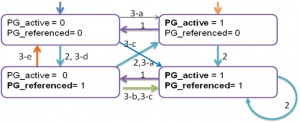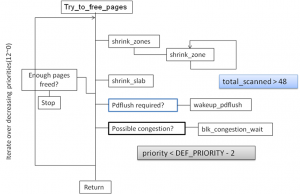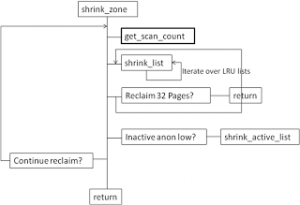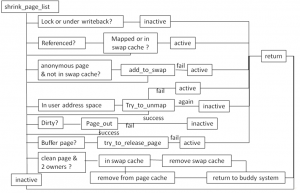blog.tek-life.com/认识linux物理内存回收机制/
Introduction
本文所讲的物理页面回收是指动态的回收:即,空闲的内存不够用的时候,系统采取相应的方法将正在使用的内存释放,补充空闲内存,以满足内存的分配。
Text
1.All channels for page freeing。首先先简单看一下系统中的内存释放的三种渠道。
1-1>. 在用户进程退出的时候,释放内存。当用户进程退出的时候,会调用do_exit. do_exit最终会调用free_pagetables函数。该函数的作用是:遍历vma,根据vma中的虚拟地址找到实际的物理页,将其释放。在之前讲过,对于用户进程的虚拟地址区间,是以红黑树组织的。
1-2>. 手动的释放。在驱动中,分配内存使用alloc_pages(),释放内存用free_pages(这一点,类似于c语言中的malloc和free)。必须配对使用。否则会造成内存泄漏。
1-3>. 按需求调用内存回收例程来释放内存。这个区别于前两种的最大不同:它是动态的,按需的。当内存不够的时候,系统会自动按照一定的方式,将某些正在使用的内存释放掉,放进buddy system中再利用。
2. Overview for page frame reclaiming。
2-1>. 先来看一下内存将会回收哪些页面
2-2>. 内存回收采用的主要算法是近似于LRU的算法。位于LRU链表前面的页是活跃的,位于LRU链表后面的页是不活跃的。为什么说是近似呢?
简单看一下Second-Chance Algorithm. 当一个页从一个LRU链表上除去的时候,需要再看一下Referenced标志。如果该标志设置了,就将其置为0,不能将该页移出。
以图一为例,当某个页面被访问后,Referenced标志被设置。当需要从该list上面回收某些页时,从后向前扫描该list上的页面。对于那些设置为1(Referenced标志被设置),reset为0,不被移出链表。对于那些设置为0的页面,移出链表。
2-3>. Linux为了实现该算法,给每个zone都提供了5个LRU链表。这5个LRU链表分为3类,一类是活跃链表(active list),活跃链表有两个:一个是链接file page cache的LRU list, 另一个是链接anonymous page cache的LRU list. 另一类是非活跃链表(inactive list),非活跃链表也有两个:一个是链接file page cache 的LRU list, 另一个是链接anonymous page cache的LRU list. 内存回收例程从inactive list链表上获取页进行回收。第三类是unevictable链表,这个链表上挂载的是那些被mlock()或者locked的页面。Mlock(),是一个系统调用,用户程序通过该系统调用锁定某些页阻止系统将其换出。被Locked的页面通常是文件系统防止其他进程touch的页面。被锁定的页面都挂载unevictable链表上。
加入到active list链表上的页其page->flags上都要设置PG_active标志。凡是设置了PG_unevictable标志的都要挂载unevictable LRU list上。没有设置PG_active/PG_unevictable标志的都处于inactive状态。处于相关状态的页面通过page->lru 链接到对应的链表上。
当某个页被访问后,提高该页面的活跃度。提高活跃度的方法是:或者对page->flags设置PG_referenced标志,或者对page->flags设置PG_active(同时该物理页面从inactive_list链表上转移到active_list链表上). 有PG_referenced和PG_active标志,可以得到页面的状态,该活跃度由低到高依次为:00->01->10->11
2-4>. 对于一个可回收页面,按照LRU的算法,只有处于inactive状态的页并且没有设置PG_referenced标志位的页才能被回收。但实际上Linux在实现的时候并没有严格按照这中算法,PG_referenced位只是用来参考的。从下面的状态转换图中可以看出这一点。状态转换图一共有4种状态。
当页面通过page fault被分配的时候,file page cache 被加入到非活动链表中(inactive list), 匿名页(anonymous page cache)被加入到活动链表中(active list)。该状态迁移图所涉及的函数主要有以下几个:shrink_active_list,make_page_accessed,page_check_references。
1)当inactive链表上的页数不够的时候,会调用shrink_active_list,该函数会将active链表上的页move到inactive链表上。对应于上图标号为1的转移;
2). make_page_accessed().
1
2
3
4
5
6
7
8
9
10
11
12
13
14
15
16
17
18
355 /*
356 * Mark a page as having seen activity.
357 *
358 * inactive,unreferenced -> inactive,referenced
359 * inactive,referenced -> active,unreferenced
360 * active,unreferenced -> active,referenced
361 */
362 void mark_page_accessed(struct page *page)
363 {
364 if (!PageActive(page) && !PageUnevictable(page) &&
365 PageReferenced(page) && PageLRU(page)) {
366 activate_page(page);
367 ClearPageReferenced(page);
368 } else if (!PageReferenced(page)) {
369 SetPageReferenced(page);
370 }
371 }
372 EXPORT_SYMBOL(mark_page_accessed);
当通过read()系统调用或者读已经在cache中的页面时,会提高页面的活跃度。对应于上图标号为2的转移(00->01->10->11);
3) shrink_page_list->page_check_references()
1
2
3
4
5
6
7
8
9
10
11
12
13
14
15
16
17
18
19
20
21
22
23
24
25
26
27
28
29
30
31
32
33
34
35
36
37
38
39
40
41
42
43
44
45
46
47
48
49
50
51
52
53
54
55
56
57
58
704 static enum page_references page_check_references(struct page *page,
705 struct mem_cgroup_zone *mz,
706 struct scan_control *sc)
707 {
708 int referenced_ptes, referenced_page;
709 unsigned long vm_flags;
710
711 referenced_ptes = page_referenced(page, 1, mz->mem_cgroup, &vm_flags);
712 referenced_page = TestClearPageReferenced(page);
713
714 /* Lumpy reclaim – ignore references */
715 if (sc->reclaim_mode & RECLAIM_MODE_LUMPYRECLAIM)
716 return PAGEREF_RECLAIM;
717
718 /*
719 * Mlock lost the isolation race with us. Let try_to_unmap()
720 * move the page to the unevictable list.
721 */
722 if (vm_flags & VM_LOCKED)
723 return PAGEREF_RECLAIM;
724
725 if (referenced_ptes) {
726 if (PageAnon(page))
727 return PAGEREF_ACTIVATE;
728 /*
729 * All mapped pages start out with page table
730 * references from the instantiating fault, so we need
731 * to look twice if a mapped file page is used more
732 * than once.
733 *
734 * Mark it and spare it for another trip around the
735 * inactive list. Another page table reference will
736 * lead to its activation.
737 *
738 * Note: the mark is set for activated pages as well
739 * so that recently deactivated but used pages are
740 * quickly recovered.
741 */
742 SetPageReferenced(page);
743
744 if (referenced_page || referenced_ptes > 1)
745 return PAGEREF_ACTIVATE;
746
747 /*
748 * Activate file-backed executable pages after first usage.
749 */
750 if (vm_flags & VM_EXEC)
751 return PAGEREF_ACTIVATE;
752
753 return PAGEREF_KEEP;
754 }
755
756 /* Reclaim if clean, defer dirty pages to writeback */
757 if (referenced_page && !PageSwapBacked(page))
758 return PAGEREF_RECLAIM_CLEAN;
759
760 return PAGEREF_RECLAIM;
761 }
该函数被真正的页面回收函数shrink_page_list调用。所处理的对象是处于inactive状态的页面。分以下几种情况:
3-a). 如果是匿名页,并且最近被访问过(PTE_young置位),对应3-a的转移(Line 726)。即(inactive+PG_referenced)->active,inactive->active. (01->10或者00->10).
3-b). 如果是已经映射的文件页,最近被访问过(PTE_young置位),如果PG_referenced置位或者被两个进程最近访问过(这一点不知道理解的对否)(Line 744~745),对应于3-b的转移(01->11)。
3-c). 如果是已经映射的文件页,最近被访问过(PTE_young置位), 并且该page cache中的内容是可执行的(例如,用户进程的代码段),则inactive->(active+PG_referenced).(00->11, 01->11)
3-d). 如果是已经映射的文件页,最近被访问过(PTE_young置位), 则,设置PG_referenced标志,仍旧保留inactive状态,不进行回收。(00->01,01-01)
3-e). 除了以上情况,均进行回收。即:最近没有被访问过(PTE_YOUNG没有设置)的匿名页和文件页。
对于page_check_references()中的返回值,简单介绍一下:
2-5>. 由以上的状态转换图,简单了解一下一个可回收的物理页面可能的生命周期。
Free->inactive->[active]<–>inactive->reclaimable->free
对于一个文件页,其在buddy system中未被分配时,处于free状态。当被分配后,首先挂载在inactive LRU list上。若被进程访问,便会被active。当一段时间没有被访问后,就处于inactive状态,挂载在inactive 链表上等待回收。被回收例程回收后,就进入buddy system中,回归到free状态。
Free->Active<–>[inactive]->reclaimable->free
对于一个匿名页,通过page fault被分配后,挂载在active链表上,然后经过deactive变为inactive然后被回收进buddy system中。
对于匿名页和文件页,刚被分配后所设置的状态,可以得出:系统总是想尽快老化文件页面。在系统的眼中,文件页的换出成本要低于匿名页。
3. Synchronization Reclaiming
当内存分配不足的时候,内存回收例程就会被调用了。相关的代码在__alloc_pages中。
若分配失败,就会进入到__alloc_pages_slowpath中。
该函数功能正如其名字所属,属于slow path。首先会唤醒各个node上的kswapd例程。kswapd是一个kernel thread,每一个node都有一个例程。该例程的函数体是kswapd().该例程会在第4节中降到。唤醒kwspad后,尝试重新调用get_page_from_freelist,分配内存。若失败,继续往下,如果需要分配内存的主儿在系统中的地位比较重要的话,会调用__alloc_pages_high_priority(). 该函数不会顾及系统设置的安全警告线(min water mark. 对于1GB左右的内存是min water mark是16MB),分配内存。如果仍然失败;则会调用__alloc_pages_direct_compat来migrate内存来达到compat的目的。这个内存的compat类似于磁盘的压缩整理,把在物理内存中正在使用的分散内存,给迁移整合,以便腾出大的连续的物理内存,满足某些进程大页面的需求。需要注意的是,压缩内存需要在build kernel的时候enable CONFIG_COMPACTION。若仍然失败,就调用__alloc_pages_direct_reclaim来回收内存了。回收内存后,会继续调用get_page_from_freelist,尝试看是否能否分配成功。如果仍然失败,并且分配内存的时候要求不允许失败,那么就进入OOM中。OOM主要的功能是选择一个占用内存量比较大的用户进程,杀掉以释放内存。释放结束后,跳到__alloc_pages_slowpath函数的开头,重新执行一遍,以满足内存分配。如果,允许内存分配失败,则就不会OOM了。以分配失败返回给调用者。
__alloc_pages_direct_reclaim函数主要调用try_to_free_pages.
try_to_free_pages()做的事情是,按照自定义的优先级从12开始,递减循环(优先级越小代表级别越高,回收的程度越剧烈)从要分配内存的zone以及其fall-back zone list中回收可用内存释放到buddy system中。它通过调用shrink_zones来达到依次扫描zone以及fall-back zone list的目的。对各个zone进行回收结束后,对slab也进行回收(本文不对slab的回收做分析)。如果至此,已经回收了足够多的内存(32个页),那么就返回。如果没有回收到32个页,则是否需要唤醒pdflush进程,该进程的作用是唤醒块设备的读写进程将脏页写到块设备上。唤醒pdflush的条件是看是否扫描了超过48个页。之后,如果这是的扫描优先级已经小于10了,那么睡眠1/10HZ,即1S.然后递减优先级,进行下一遍的循环。
关于swap cache的作用,请看下图(图9)。
有关对swap cache 作用的描述,最靠谱的分析是来自Understanding Linux Kernel. 摘录如下:
Remark:
Figure 17-8 请对照图9.
上图的函数都是来自于2.6.11内核。本文所参考的内核是3.4.因此引用中的函数可能和本文所述的函数不匹配。
4. Asynchronization reclaiming.
References
Understanding Linux Kernel (3rd).
Understanding virtual memory manager (2nd).
Professional Linux Kernel Architecture.










